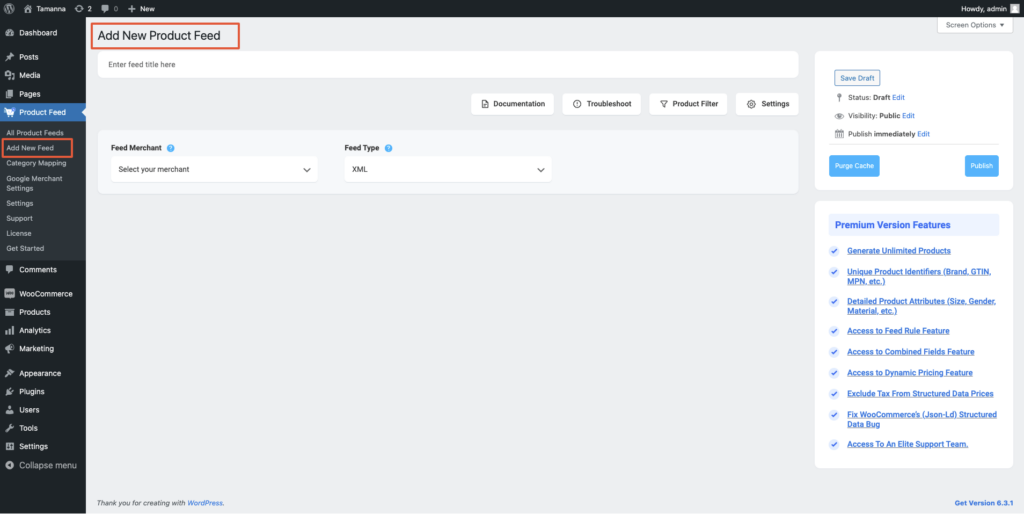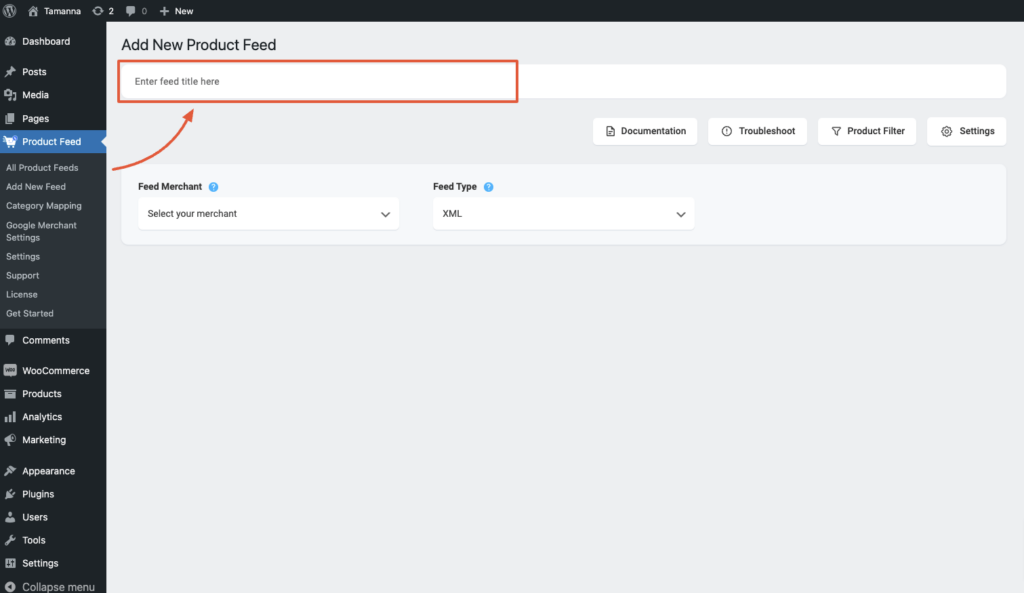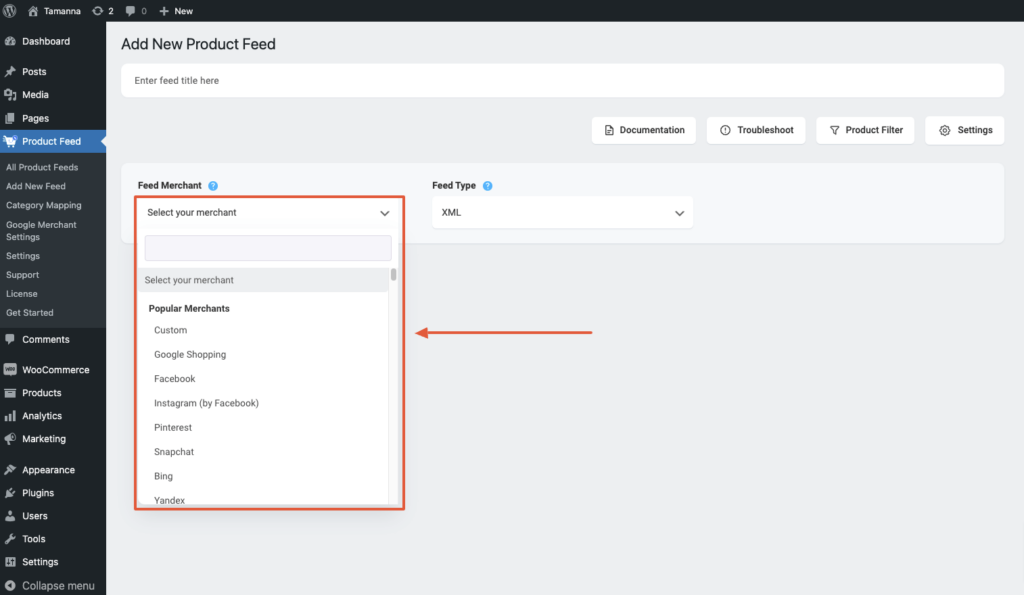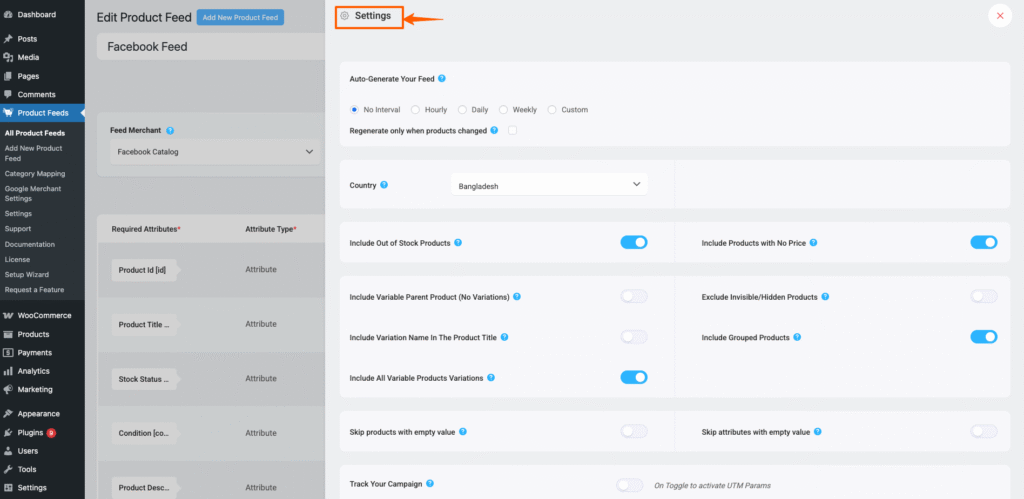Facebook is one of the most popular places to promote your products online.
In this guide, I will show you how to create your WooCommerce product feed for Facebook.
Follow these easy steps to generate a WooCommerce Product Feed for Facebook
Step 1: Create New Feed & Feed Mapping #
Go to your product feed dashboard.
Click on the Add New Feed button.
It will take you to the feed creation page.

Now, here,
1. On top, you will get the option to add a title to the feed. Give your feed a name.

2. Just under the title, you will see an option to select your preferred merchant. Simply click on the Feed Merchant dropdown button and select your preferred merchant from the dropdown or you can search in the dropdown box.

Select your preferred merchant and all the required attributes will be loaded below.
Let’s select Facebook Catalog for this feed.

**Please note that Facebook accepts both XML and CSV feed submissions, so you will get an option to choose the file format.
3. In most cases, this template is already configured and values are assigned properly, so you won’t have to do much work with this.
However, depending on the merchant you are generating a feed for, there may be some attributes for which you need to assign values manually.
For example, when you select Facebook, you will see there are two attributes ‘Google Product Category‘ and “Manufacturer” at the bottom that do not have values assigned.
What is Google Product Category Attribute?
Category Mapping is in feite het samenvoegen van je WooCommerce productcategorieën met de Google productcategorieën.
You can configure category mapping in two ways.
– Using a pre-made category mapper, which is created for Google Shopping by default.
You can reuse the Google Category Mapping for Facebook as well because Google Taxonomy is much more detailed.
To use the default category mapper which was created for Google simply select the Google Product Category mapper from the Category Mapping dropdown value:
Click on the Configure Category Mapping button which you will find under the Category Mapping value, and a new tab will be opened with the default category mapper – Google Product Category. Map your categories here and click on the Update and Close button to go back to the attribute section.
– Creating a new Category Mapper.
However, you can create a new Category Mapper too. You need to click on the Category Mapping button from the WordPress dashboard and there you will get the option to create a new Category Mapper and to configure the mapper.
You can follow this doc to learn how to create a new Category Mapper for your feed.
What is Manufacturer Attribute?
This should be the Brand name of the product you are selling. If you are the manufacturer of a single brand, you can set the type as Static and input your company/brand name here.
If you have different brand names for different products, you will have to save the value in a custom field or product attribute and then use that value here.
**You may also use Perfect Brands for WooCommerce, which will make it easier to assign and use brand names.
4. Also, if you want to add new attributes, you can click on the Add New Attribute button, and you will get the list of the optional Attributes of Google Shopping.
Or you can add a custom attribute by clicking on the Add New Custom Attribute button.
Step 2: Feed Configuration #
1. Scroll up to the top and here, you will see that there are Four options:
- Documentatie
- Problemen oplossen
- Products Filter
- Instellingen

2. First, let us configure the features in the Feed Settings. Click on the Settings button, and a drawer will open from the right side of the screen.

3. The first option you will see is Auto-Generate Your Feed.

Deze optie wordt gebruikt om een automatische update van de feed te plannen na bepaalde intervallen. Kies een optie om een auto-update in te stellen of laat het staan op "Geen interval" als je geen auto-update van de feed wilt instellen.
4. Gebruik vervolgens indien nodig de volgende opties.

- Selecteer land/regio
- Selecteer een regio uit dit vervolgkeuzemenu als je de verzendgegevens in je feed wilt opnemen. Zodra je de regio hebt geselecteerd, moet je het kenmerk Verzenden aan je feed toevoegen om de waarden voor Verzenden te krijgen.
- U kunt dit document volgen om te leren hoe u de verzendinformatie in uw feed kunt opnemen.
- Include Out of Stock Products
-If you want to include the out-of-stock products, then you can enable the option.
-For this feed, let’s not use this option and keep its value as “No“. - Include Variable Parent Product (Without Variations)
-If you want to include the parent feed for variable products, then you can enable the option.
-Few merchants such as Google Shopping or Facebook don’t require you to submit parent products, however, there are many other merchants such as eBay MIP, that require you to submit parent products in the feed.
-For this feed, let’s not use this option and keep its value as “No“. - Include All Variable Products Variations -
-Als je alleen eenvoudige producten wilt opnemen in de feed en geen variabele producten, houd de waarde dan op "No".
-Als je zowel eenvoudige producten als variabele producten wilt indienen bij Google Shopping, houd de waarde dan op "Yes".
-Laten we deze functie gebruiken en markeren als "Yes", voor deze feed. - Include Variation Name In The Product Title
-Few merchants such as Google Shopping, suggest you add the variation term to the Product name in case you are uploading variable products, however, it is completely optional.
-So if you want to include the variant terms to the variable product names, then you can set its value as “Yes“.
-Let’s use this feature, and mark it as “Yes“, for this feed. - Inclusief gegroepeerde producten
-Als u gegroepeerde producten hebt, dan kunt u het beste het bovenliggende product van het gegroepeerde product dat u hebt gemaakt indienen.
-Dus moet u deze optie aanvinken met "Ja". - Exclude Invisible/Hidden Products
-You might have certain products on your store that are marked as hidden or invisible on WooCommerce.
-If you want to generate feed for Simple products only, then you can mark this option as “Yes” to exclude invisible products from the feed.
-However, product variants are by default marked as Invisible on WooCommerce. So if you include variable products to the feed, then you should mark this as “No“.
-Since in this feed we are including product variants, we will not use this feature and keep it as “No“. - Elk attribuut overslaan als de waarde leeg is
-Inschakelen van deze functie sluit alle attributen van een product uit als de waarde van het attribuut ontbreekt.
-Voor deze feed zullen we deze optie niet gebruiken en de waarde ervan op "Nee" houden.
5. You can then find an option to add Track Your Campaign (Analytics parameters).

Gebruik deze optie als u analyseparameters wilt toevoegen aan productlinks in uw productfeed, zodat u de prestaties van de producten op Google Shopping kunt volgen.
6. Now, close the drawer and click on the Product Filter option. A new drawer will open from the right side of the window.

7. Click on the dropdown, and You will get the following options:

Choose the Products you want to include in the feed.
You may choose to include:
– All Published Products
– All Featured Products
Or you may use one of the Listed filter options,
– Category Filter,
– Tag Filter,
– Brand Filter
– Custom Filter,
to include the products you require (or exclude the ones you do not want to include).
For a basic feed, you can keep it the same.
Step 3: Publish The WooCommerce Product Feed for Facebook #
Nu je feedconfiguratie klaar is, is het tijd om de feed te publiceren.
Scroll terug naar boven, en u vindt rechts een knop Publiceren.

Klik op de knop Publiceren, uw feed wordt gegenereerd.

That’s it. Your XML feed for Facebook is generated. You can now download and upload this file to your merchant account and list your products on your Facebook shop.
Follow this doc to learn how to upload your feed on the Facebook shop: How to upload your WooCommerce products on the Facebook store
Also, you can have a look at the following docs to learn how to include Shipping and Tax information on your feed items:
How to include Shipping values into WooCommerce product feed
How to include Tax values into your WooCommerce Product Feed